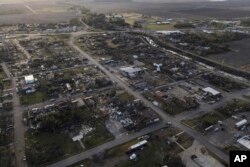Dozens of relentless tornadoes tore through parts of the southern and north-central United States, killing at least 18 people. Meteors tore through the Arkansas capital, brought down the roof of a packed concert venue in Illinois, and smashed homes, schools, and businesses across cities and towns. On Saturday, people across the region were stunned by the destruction that occurred overnight.
Confirmed or suspected tornadoes have destroyed buildings in at least seven states, snapped trees and leveled neighborhoods in a swath of the country home to some 85 million people. There were seven deaths in Tennessee’s McNairy County, four in the small town of Wynne, Arkansas, and three in Sullivan, Indiana.
Other deaths were reported in Alabama, Illinois and Mississippi, as well as one fatality near Little Rock, the Arkansas capital, where the mayor said more than 2,000 buildings were caught in the path of a tornado.
Tens of thousands lost power as storms battered a swath of the country where some 85 million people live. The dead included four in the small towns of Wynne, Arkansas, and three in Sullivan, Indiana. Other deaths were reported in Alabama, Illinois, Mississippi, and the Little Rock area.
Stunned residents of Wynne, a community of about 8,000 people 50 miles (80 kilometers) west of Memphis, Tennessee, woke up Saturday to find the roof of the high school smashed and windows blown out. Huge trees lay on the ground, their stumps reduced to lumps. Broken walls, windows, and roofs punctured homes and businesses.
“It saddens me that my city has been hit so hard,” said Heidi Jenkins, a salon owner. “Our school is gone, my church is gone. I am sad for all the people who lost their homes.”
Recovery was already underway, with workers using chainsaws to cut downed trees and bulldozers moving material from wrecked structures. Utility trucks worked to restore power. Groups of volunteers came together to plan their day.
As Jenkins was speaking to a reporter, a passerby in a car yelled, “Do you want fried pies?”
In Belvidere, Illinois, a tornado collapsed the roof of the Apollo Theater as 260 people were attending a heavy metal concert, killing one person and injuring 28, five seriously, authorities said.
People rushed to lift the collapsed part of the roof and pull people out of the rubble, Gabrielle Lewellyn, who had just entered the theater, told WTVO-TV.
“Someone was pulled out of the rubble, and I sat down with him, held his hand, and said, ‘He’s going to be okay.’ I really didn’t know much else what to do,” Lewellyn said.
The weather service is already forecasting more severe storms next Tuesday in the same general area as Friday with a fairly high level of certainty.
The current persistent pattern of storm ingredients reminds Gensini of the April 2011 tornado attack that killed 363 people in six states, hitting Alabama hardest. That was one of the largest, deadliest and most destructive tornado outbreaks in US history, the weather service said.
Even before Friday, “it’s been the most active we’ve seen in several years” starting last November, with a large number of winter storms through this year, Elliott said. The deadly storms that hit the Rolling Fork were part of that pattern.
Buckingham and the other meteorologists said the current conditions appear only once every few years to create the potential for a train of supercells, bringing the worst of the damaging hail and tornadoes.
Central to this is a fast-moving rollercoaster-like jet stream, the river of shifting air that moves weather systems, like storms, from west to east. On the west side of the jet stream is extremely cold air and to the east, parked off Florida and the Caribbean, is a very warm and dry high pressure system.
“When you combine the two, it makes those hairs on the back of your neck stand up,” Buckingham said. “The ingredients are here. They’re prepared toward the end of things,” she noted.
Add to that that the Gulf of Mexico, which provides moist heat and power for storms, is about 2 to 5 degrees warmer than average or more, forecasters said, “on fire,” as Ashley put it.
“The extra heat and moisture really makes these thunderstorms kick in,” Buckingham said.
The worst weather will be “below the shock” of hot and cold air, something of a battlefield, Gensini said. The Friday lunchtime forecast in Storm Lake, Iowa, is around 67 degrees (19 degrees Celsius), but just 140 miles (225 kilometers) to the northwest, Brookings, South Dakota, is forecast just shy of above freezing point.
“The greater the temperature gradient, the stronger the storm systems,” Gensini said.
Winds spinning in opposite directions to the west and east of the jet stream battlefield add to the problem, forecasters said.
Ashley said current conditions are mostly random weather variability, though he said the warmer Gulf of Mexico and the human-caused climate change they may have made a small contribution.
“These events have always occurred,” Ashley said. “The question is, are we turning the knob a bit by contributing more moisture, more heat, more instability?”
[Con información de The Associated Press]
Connect with the Voice of America! Subscribe to our channel Youtube and activate notifications, or follow us on social networks: Facebook, Twitter and Instagram.

















